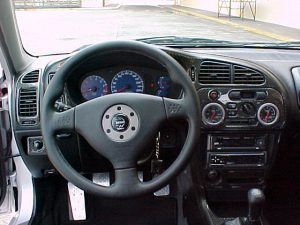Ford Escort RS Cosworth history and technical infos
Ford cars have been involved in rallying since the late 60s. Not much success though on their account although many individual victories were achieved, most of them due to individual and private efforts until the early 70s when the first, legendary, Ford to race in the World Rally Championship the Escort RS (Mk I and Mk II series) 1600 then 1800 and finally 2000. Juha Kankkunen, Ari Vatanen and Stig Blomquist all started their racing careers in that car. The situation changed somewhat in the late 80s when the Ford motor company associated with its old partner Cosworth Engineering started producing cars that could be considered for use in world rallying. The name Cosworth, made-up from the two founding engineers of the company Mike Costin and Keith Duckworth, is world famous in racing. The Cosworth company has since been split in many entities and, while the engineering part is now owned by Audi, the Cosworth Racing part is still owned by Ford. The Ford Cosworth series of cars spanned from 1986 to 1996 and were based on the old but solid Ford Pinto derived four cylinder cast iron block powered by an aluminum 16 valve head . The engine consisted of in-line 4 cylinder units with 2 overhead camshafts and was blueprinted from its origin as a supercharged unit using Garrett Air Research turbochargers. The engine had a 2 liter displacement and its output was initially 204 Bhp. The latest models had units with up to 227 Bhp output.
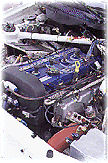
The Escort Cosworth YBT engine (notice the blue camshaft cover: These denote the engine type, red for versions running on premium gas, green for those running on unleaded and blue for those running on unleaded gas with a catalytic converter fitted)
The Escort Cosworth YBT engine (notice the blue camshaft cover: These denote the engine type, red for versions running on premium gas, green for those running on unleaded and blue for those running on unleaded gas with a catalytic converter fitted)
The YB series of Cosworth engines are “super square”, short stroke i.e. bore is greater than stroke (90,8 x 77,0 mm in this case) thus advantaging high rev output rather than low end torque as is the case in long stroke engines. It’s a fact that all Cosworth engines, even heavily modified ones, require to be operated in relatively high revs in order to be responsive. These fantastic, race bred engines are very conservatively rated in out-of-factory cars at approx. 220Bhp. They easily withstand outputs in excess of 300Bhp with little to no reliability problems (provided the up-rating is done by specialists such as Graham Goode Racing, Mountune and others).
First in the Ford Cosworth car series was the “homologation special” RS500 (224 Bhp in its street version), a car based on the Sierra chassis, easily recognizable by its huge rear spoiler (which made the Ford marketing department go crazy but was finally imposed by the development team). The RS500 was a 2 wheel drive car (the rear wheels). The RS500 was mainly destined to track racing and, as its name suggests, was produced in 500 samples. It was followed by a new Sierra (a.k.a. Sapphire) based Cosworth powered car which was heavily involved in world rallying in the hands of drivers such as Miki Biasion, Didier Auriol and Fran√ßois Delecour. The Sierra RS Cosworth was, initially, a 2 wheel drive car very similar, mechanically, to the RS500. Later a 4 wheel drive version was introduced which used the classic Ferguson layout (2 viscous coupler equipped differentials are used, one between the front and rear axles and one in the rear axle). The commerce (street) version was fitted with a 204 Bhp output unit and had a torque distribution was 34% in the front and 66% in the rear wheels. Most competition cars had a 50-50 torque distribution (although this could vary with some cars using 34/66 F/R distribution on tarmac).
The Sierra RS Cosworth had some success but did not score a single win in the WRC in its 4WD version (it did score 1 win in its 2WD version) and was not really able to compete with the Lancia Integrale, which was dominating the rallying world at the time, especially because of its size and weight. The Sierra Cosworth was based on a family sedan and thus had some inertia problems whereas the Lancia was much more compact and versatile. Ford Motorsport came up with an alternative and the declared ambition to beat Lancia. This alternative was the Escort. Well, not really.
Ford developed a car based on the Sierra Cosworth chassis and mechanics but housed in an Escort looking outfit. Of course the Escort shell could not fit all these extra attributes i.e. north-south engine, four wheel drive, etc. so the chassis were sent from England to Germany were Karmann would cut, fit and re-adjust them so that Ford were able to put the Sierra parts in the Escort. Small changes were brought to the engine management system and a new, hybrid, turbocharger was fitted. You can check the street version’s specs compared to the competition version here. Also available are the specs of my Escort RS Cosworth’s compared to the street version here. You can also find lots of pictures of my car starting here.
A grand total of 7’145 vehicles, all practically hand built, were produced between 1992 and early 1996. That’s to say the Ford Escort RS Cosworth is a relatively rare car. The total production figure is equivalent to 4 days production of the Volkswagen Golf…
Escort RS Cosworth production numbers (Kindly provided by John R. Bull of Ford’s SVE division):
| Year | Cars produced |
| 1992 | 3’448 |
| 1993 | 1’143 |
| 1994 | 1’180 |
| 1995 | 1’306 |
| 1996 | 68 |
Two versions of the street Escort RS Cosworth were produced. The initial 2500 units were pure “homologation specials” used to get the FIA accreditation in group A and were fitted with an oversized Garrett T3/T04B turbo (this turbocharger is a hybrid consisting of a Garrett T04B compressor wheel combined with a Garrett T3 turbine and is also known as T35). This is the same device as the one fitted to the Ford RS200 GroupB car of old. These units displayed significant turbo lag due to the huge inertia introduced by the T35 unit and the detuned nature of their competition derived engine. The cars equipped with the T35 turbocharger cars used the YBT variation of the Cosworth engine (a total of 5’186 YBT engines were made). You can take a look at the YBT engine here . Among these initial units some, the ones denoted “Motorsport” versions, lacked the otherwise standard sunroof and rear tilting windows and had water injection equipment packed in a bag in the car’s trunk (i.e. not mounted) so that the race cars could be fitted with it. A funny anecdote is that cars which would race in group N (production cars) could be checked to see if the water injection device was in their trunk (i.e. not fitted on the engine). Some competitors were not allowed to race in group N Escort RS Cosworth cars due to the absence of this non-functional equipment!
The second generation of the Escort RS Cosworth was a bit more “civilized” than the first. The only exterior difference, compared to the “big turbo” version, was an HTT (High Torque Turbo) logo on both front doors. These cars, starting from late 1994, were fitted with a Garrett T25 turbo (much smaller than the huge T35, the T25 is using a T2 turbine and a T03 compressor wheel), the same turbo that was mounted on Fiat Uno Turbos! This engine was code named YBP. You can take a look at the YBP engine here and here. Note however that one could still order a “big turbo” Escort RS Cosworth while the HTT versions were in production. Major engine and engine management changes were also implemented. The Weber-Marelli IAW P8 management system was replaced by a Ford EEC IV unit which is much less versatile. The ignition system now had one coil per cylinder compared to the static ignition system found in the original version (no distributor is used). Bigger oil projectors were placed under the piston heads for cooling purposes and a new engine head design was applied. By applying all these modifications Ford hoped to be able to sell more cars since in the HTT version the turbo lag time was dramatically reduced as compared to the T35 based version and the cars were easier to drive in everyday traffic conditions. Note, however, that not only the T25 turbocharger’s output drops significantly above 5’500 RPM but that the aftermarket modifications, so common on Marelli based ECUs, were much harder to implement properly on the much more restrictive EEC-IV unit. I think the shift from the big turbo to the small turbo version was a pure marketing trick which, as always, does not take into consideration the motivations of the real buyer base. This breed of car is bought by enthusiasts to whom turbo lag, engine responsiveness in low revs, or even harshness are not very relevant.
The Ford Cosworth series of cars (Sierra, RS500, Sapphire, Escort) share a number of components and technical solutions that grant them a common family feeling.
The suspension geometry and layout was maintained with minor modification throughout the series and uses classic Ford-style solutions of the time.
The front McPherson struts use a lower track control arm which, although adequate in less powerful cars, quickly shows its limits in the Cosworth series. A lower wishbone would have been a much wiser choice here. Note that the front anti-roll bar is also connected to the strut and is thus used as a secondary control arm but still one feels the need for more precision and control in sudden direction changes. The competition versions used a similar design with titanium parts (hubs and control arms) but the relocated attachment points and altered geometry allowed for better control and feel of the front drivetrain.
At the back we find another classic Ford solution of those days with the use of a McPherson strut this time using trailing arms, transversally mounted, which provide adequate wheel control. Here the main problem lies with the design of the control arms and whole suspension structure which are made in steel tube, of variable almost square section. The tubes are made of seam welded steel sheets. The whole rear suspension is connected to the car’s chassis through another steel tube structure which is fitted on the chassis by rubber bushes. As you see the main rear suspension problems are: rigidity (its absence rather, especially when the bushes are used) and its tendency to deformation (under extremely high stress or when hitting curbs the steel tube structure may bend).
In short, although no revolutionary solutions were used in the suspension of the car, the standard Cosworth will provide adequate handling and control in all but the most extreme situations.
Of course the first series (big turbo) of the Escort RS Cosworth was the “homologation” base used for the rally cars. The major competitors in WRC (those with the most sponsors and subsequently the most important budgets) had cars which remotely resembled the base (production) car but were light years away from it mechanically. Here are the major changes in the Group A car as compared to the production car:
- Chassis are reinforced (roll cage), seam welded and many new welding points are applied.
- The suspension housing tunnels are reinforced with welded upper aluminum/titanium plates to allow suspension angle adjustment
- The suspension layout is modified (it has to retain the same principle as the production car i.e. McPherson) so that all angles as well as the ride height are adjustable in situ. The rear suspension also uses a McPherson layout which was later replaced by a multilink layout in the Escort WRC car. Shock absorbers are liquid cooled and non linear (progressive) springs are used
- The brake system is completely free in GroupA. No ABS or servo assistance is used. There are two brake circuits and two master cylinders. The front brakes (depending on the type of rally) are usually √ė378mm with 8! pot calipers and 4 brake pads each. Rear brakes are √ė315 with 4 pot calipers. The front brake calipers are water cooled with separate water pumps, radiators and reservoirs. Braking force bias (front/rear) can be changed from the cabin
- The gear box used is an MS95 7 speeder (non sequential) with the first ratio removed. Dual plate carbon dry clutches are used. The gear box uses an oil pump and an oil radiator to keep cool. (Note that this gearbox was replaced by an X-Trac sequential one since the New Zealand ’97 rally)
- The steering is a rack and pinion based high ratio (12:1) with 2.4 turns from lock to lock. Servo steering assistance is available. The steering oil uses a radiator for cooling
- A bigger intercooler is fitted in a different location than in the production car. Additional cooling is provided by an external water spray system. Air intake temperature is always around 40¬įC ! Water injection is also fitted
- The fuel tank is re-located inside the car’s trunk and is compliant to FIA regulations (80 lt. capacity)
- The engine is heavily modified. The crankshaft is made of a single piece of steel and is lightened and balanced. Titanium driveshafts are used as well as forged aluminum pistons. The outlet valves have lithium inlays. The engine head is polished and wider valves are used throughout. The camshafts are specific, the compression ratio must be around 8.5. An FIA 34 mm restrictor is used on the turbo. Two high pressure fuel pumps are used. Two supplementary liters of oil are used, compared to the production car (a total of 8lt). Magnesium oil sump. Turbo boost pressure is in the 2.5 bar+ region. Bang-bang switchable from the cabin
- The transmission system is also completely different than the one fitted in the stock car. Three self locking differentials are used. The center and front ones are computer managed. Two hydraulic pumps feed them with pressure (0-50 bars). The computer management can be overridden by the driver who can adjust the torque distribution, between the front and rear axle using an onboard button. The center differential is automatically disconnected whenever the driver pulls the parking brake. All differentials are connected to oil coolers
- The electrical system is completely redesigned and complies with aviation standards (i.e. pricey)
- 18″ magnesium wheels are used on tarmac
- The car’s laden weight is 1230Kg
You realize why works cars used to cost from US 500,000 up and why only few drivers could get their hands on them. There are extremely few parts that have their origin in the street version, if any.
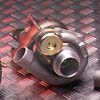
The Garrett T35 turbocharger

Cosworth YBT engine
Ford says that the engine’s output is 300 Bhp with the 34mm turbo restrictor fitted (as does Lancia, Mitsubishi, Subaru, Toyota and others since this number is the maximum set by FIA regulations). Of course no one believes them since you can get that kind of output from a stock Escort Cosworth with minor engine management modifications. I’ll quote Didier Auriol‘s co-driver, Denis Giraudet, who once declared: “Last year we had 300PS. This year we still have 300PS after changing almost all engine parts and running at least 1 sec faster/Km…”
A better guess is that these cars must have an output of at least 350 Bhp with the 34 mm turbo restrictor fitted. Ford Motorsport claim a 3s 0-100 Km/h in any conditions (including gravel)!
Ford put a lot of effort in the chassis design of the Escort RS Cosworth. The bodyshell is extremely rigid as it takes a torque of 6000 N/m to induce a body torsion of 1 degree! The car’s aerodynamics are also exceptional considering the additional drag produced by the cooling drag and spoilers. The car’s Cx index is “only” 0.38 when a normal Escort has a Cx index of 0.34. Additionally the Escort RS Cosworth is the only production car that generates a positive downforce (which is the least one can say considering the huge spoilers fitted). The front spoiler and splitter will generate a 45 Newton down force at 180 Km/h while the rear generates a 190 Newton downforce at the same speed. Note that the splitter installed beneath the front spoiler is adjustable in three positions and that the downforce stated above is produced with the splitter in its middle position. The Escort RS Cosworth testifies of its racing heritage in another field too, accessibility to all mechanical parts. The gearbox, suspension, engine and differentials are all very easily and individually accessible for servicing purposes. This is not often the case in previous and other current production cars.
The commercial version of the Escort RS Cosworth, in its standard spec, is not a very pleasant car to drive. The driver feels the lack of development in the chassis and engine. To Ford, the car was a simple homologation special and as such the company did not (would not) take the time to develop a coherent ensemble. The car is characterized by a front drivetrain which is a bit too sharp due to the very direct and overly assisted steering, the absence of lower wishbones and the huge grip of its enormous Pirelli PZero tires. The engine is too harsh and the turbo lag reminiscent of much older times (read Renault 5 Turbo). The chassis’ stiffness increases the driver’s sensation of the suspension’s and engine’s shortcomings. These problems nourish the aftermarket parts business and it is quite rare to find an Escort RS Cosworth in its standard spec. Most cars are modified to different extents by the successive owners in order to render them closer to what they should have been in the first place…From a development perspective the Escort RS Cosworth is much less accomplished than other homologation special cars.
The standard Escort RS Cosworth exhibits a more track oriented handling character than a gravel or open road one. The car has a pronounced understeering trait during the turn-in phase which, accompanied by the important turbo lag of the T35 turbo charger, forces its driver to use very clean trajectories more usual on a track than an on open road or a slippery surface. The initial understeer is followed by a pronounced and sudden oversteering at the corner’s exit and requires quite a bit of concentration and getting used to in order to achieve efficiency. Of course such techniques are not applicable to gravel or, generally speaking, slippery conditions where cars are driven more based on inertia and momentum than perfect trajectories. That’s the reason why the Escort was far more performing in tarmac rallies rather than gravel or snow-covered events.
The competition the Escort RS Cosworth managed to score a total of 8 WRC wins in its GroupA outfit and 2 in its WRC class version. The car would have deserved a far better score if it wasn’t for Ford’s inconsistent management, the lack of budget and Fran√ßois Delecour‘s terrible accident which kept him away from competition for over a year at a very crucial moment in the car’s career.
All the impressive specs, features and performance are now gone. The Escort RS Cosworth is dead due, in part, to new noise emission regulations applied in the European Union in 1995. Ford were unable to meet the new standards and the last car was produced in early 1996.
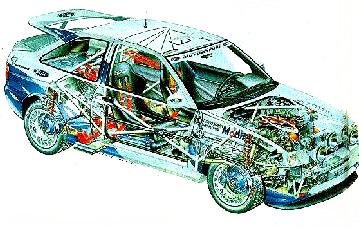
The Group A version of the Escort Cosworth
Nowadays cars are created from scratch in computers and are supposed to handle great even in prototype versions. I still have to see a single one handling as well as a Ford Escort RS Cosworth or a Lancia Integrale. This breed of car is gone, drown in a world where all cars look the same, drive the same and are engineered in the same way. Features such as the number of airbags or electronic control systems are now more important, it seems, than driveability and driver satisfaction. Maybe that’s what some people call progress. Anyway, enough complaining, if you want to know how the 4wd rally cars handle click here.
In early 1997 David Richards (Subaru Prodrive Team manager) convinced the FIA to modify the WRC rules and have a new kind of rally car homologated, the WRC cars which dominate the rallying world today (although the 1998 and WRC champion was still a GroupA car, the Mitsubishi Lancer Evolution V). One of the problems of the new regulations is that WRC cars have no longer production counterparts. Ordinary people like you and I can no longer hope driving one of those.
Ford replied to Richards with a modified Escort Cosworth, designed by an ex-Mitsubishi (Ralliart) engineer, which was a hybrid WRC car. By hybrid I mean the car was not designed from scratch, as was the Subaru Impreza WRC, but is rather an evolution of the old group A car. The main changes include an new turbo provider (IHI, this choice proved catastrophic later but there was no turning back), a new engine management system (Ford/Pectel), a new engine parts provider and tuner (Mountune) and new suspension layouts and parts.
During the 1998 season Bruno Thiry and Juha Kankkunen were driving for the Ford WRC team. Note that Juha Kankkunen, 4 times World Champion and probably the best driver in the WRC history, accepted to drive the Escort for free during the 1997 season. It’s a tough world!!!
Everyday life with a Ford Escort RS Cosworth
The Escort Cosworth (and Sierra) are really easy cars to live with. Not many problems, that I know of, have been reported about them. One or two small defects were present on the first series of cars (pre-1994) and most are covered by the Ford warranty. For instance the front suspension bushes were undersized and this lead to excessive front tire wear (the inner part of the tire was used more than the outer). The gearbox synchromeshes for third and fourth gears were not correctly sized either. This lead to difficult gear switching in high rev situations (almost all the time). I have heard rumors saying that valve guides should be replaced after 80,000Km (expensive US 2,000+) although I haven’t experienced that yet (my car has covered 48,000Km thus far).
All in all these cars are much less troublesome than the Lancia Delta Integrale is. If you are able to still find one, especially one in good condition, and have the cash do not hesitate. You could consider buying one as an investment although it would be a pity not to drive it from time to time. The Escort RS Cosworth is a car made for car loving persons.
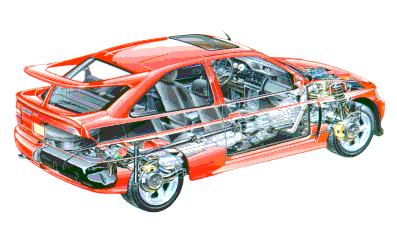
The street version’s cutaway

